You may have heard of Anila Quayyum Agha from ArtPrize, the city-wide international art exhibition and competition held annually in Grand Rapids, Michigan. The exhibition, now approaching its 10th year, provides artists with an opportunity to win a cash prize of $200,000. Two prizes of this size are awarded – one by a jury of art experts, the other by popular vote of visitors to the exhibitions. In 2014, Agha’s exceptional piece, “Intersections”, won the Public Vote Grand Prize and tied with another entry to split the Juried Grand Prize.
Visitors to the Cincinnati Art Museum were able to see Agha’s 2016 iteration of similar design, titled “All the Flowers Are for Me (Red)”, on display from last June through mid-October, as the winner of CAM’s 2017 Shiele Prize. Fortunately for the Cincinnati community, it is also the first work purchased through the new Alice Bimel Endowment for Asian Art, and is now part of the museum’s permanent collection.
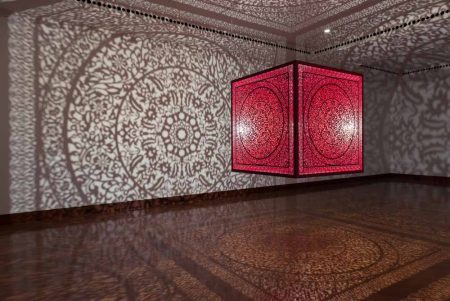
The room-sized installation consists of a 5-foot cube suspended from the ceiling, made from steel sheets laser cut into complex patterns of Islamic design, with a black exterior and red interior surface. In the center of the cube is what appears to be a single light source. Visitors entering the space become enveloped in patterns of light and shade. The effect is not subtle – a strong, point source light and intricate designs cast sharp, distinct shadows of detailed patterns that extend to the furthest reaches of a large gallery space. Although only the cube (and a visitor here and there) occupies the cavernous room, it feels as full as it does empty.
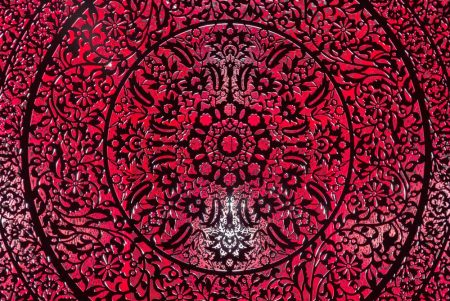
The magic of “All the Flowers Are for Me (Red)” is its simultaneous simplicity and complexity – the effect of a single light to cast the deep history and visual sophistication held within the patterns it projects. This light and shade has the ability to morph, mold and completely transform the solid walls that contain it. The shadows suggest a sense of privacy or secrecy, even though one is in public. At a bench placed at a far end of the gallery, I witnessed visitors sitting, having intimate conversation in a less than intimate volume, feeling protected by the dimly lit space. I also witnessed a single patron circling the sculpture but mainly looking into the screen of a phone, smiling and spinning around in a selfie-induced trance. The movement visible as one walks through the static field of light and pattern creates a dizzying sense of energy as well as a great photo-op.
Born in Pakistan, Agha emigrated to the US in 1999 and completed her MFA in fiber arts at the University of North Texas in 2004. She is currently a professor at the Herron School of Art and Design/IUPUI in Indianapolis. The design of “Intersections” as well as subsequent works was influenced by a 2012 research award to study the Alhambra Palace in Granada, Spain, an elaborate compound of buildings whose architecture and decorous interior served as an expression of faith and power for both Muslims and Christians over the course of its history.
As she says in her artist statement, Agha’s work “explore(s) the deeply entwined political relationships between gender, culture, religion, labor and social codes.” These concerns are particularly evident in the eight works on paper that accompany the installation. Dated 2015 through 2017, these pieces are a continuation of small scale works that Agha creates in addition to her installations. Using laser cut mylar, hand embroidery, beadwork, and in some cases encaustic, these works also explore the effects of light, shadow, transparency, opacity, and contrast. In “Shimmering Memories”, laser-cut mylar patterns form layers of dense geometric and organic designs. Silver-threaded embroidered circles and beads weave through the composition. The subtle difference in the color and transparency of layers creates the illusion of depth in the piece when viewed from different angles. Here Agha’s Alhambra study is evident; an oblique view of this piece reveals a maze-like architectural plan perspective of chambers or courtyards.
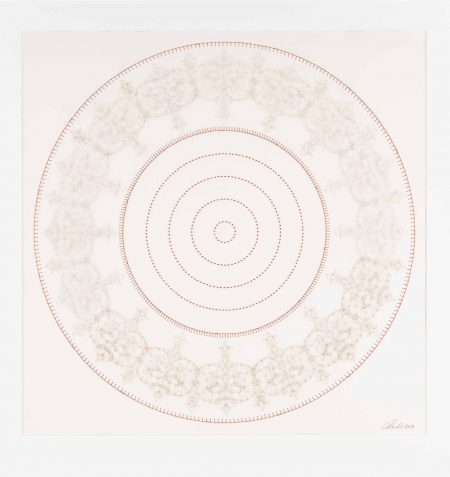
Symmetrical, grid-oriented repetition combined with fine geometric or organic detail is a prominent characteristic of Islamic design that conveys the infinite greatness of Allah in abstract terms. Agha’s use of these Islamic design conventions captivates in both her large and small pieces, and references the Muslim culture that influences her. In “Walk with Me My Beloved”, the semi-opaque mylar subtly obscures a pattern of blooms. Embroidered circles receding in size around a point, focus the eye as on the center of a target. Combined with the play of clarity within the layers of mylar and patterning, the effect is hypnotic. Many of Agha’s pieces also play with the ambiguity of figure/ground relationships. In “Antique Lace”, a symmetrical repetitive rectangular pattern, centered in the frame, is created by embroidered lines, its delicate form overtaken by the more assertive cut mylar pattern, which appears as a fragment of a larger, more encompassing design.
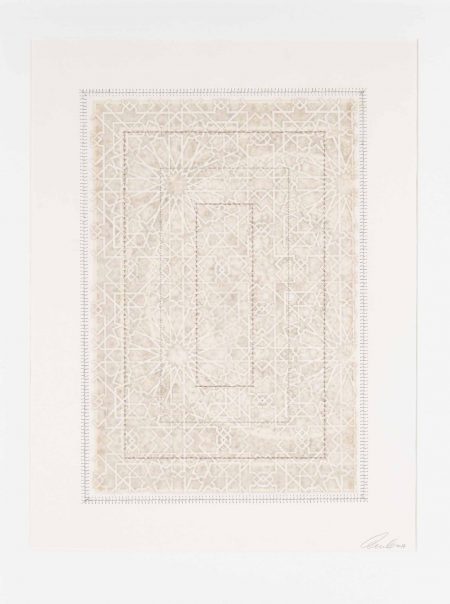
Beyond the visual effects, the technological process of laser-cutting used to create these works contrast with the gender-based, traditional domestic handwork of embroidery and lace-making. Agha’s ideas benefit from the magic (or disruption) of progress and innovation while depicting the tension between the machine and hand-made, the small scale and industrial scale, the intimacy and personal value of the labor of an individual vs. the anonymity of the labor resulting from technological processes. In “Intersections – Black 1”, the precision of the laser-cut design counters the hand-processed, irregularly colored paper. This single layer marbled-paper and encaustic work is set on a black background that becomes reflective under glass, placing viewers themselves within the light-dappled pattern that moves through the piece.
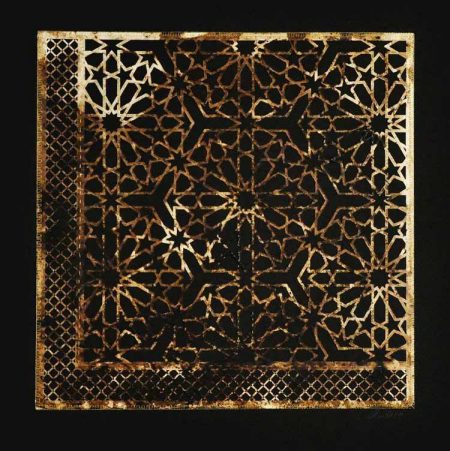
The wonderful thing about museum exhibits is the display of pieces in various collections that enable visitors to make connections across genres and periods as they wander through the galleries. Curious viewers will always find a sense of surprise and wonder in the existence of connections that span time and place; the evidence, whether visual , aural, literary, historical, or contemporary, is there for us to piece together, the comparisons there for us to ponder. Of this experience, the museum is a microcosm. I had the pleasure of experiencing this as I explored spaces deep within the museum. In a section distant from Agha’s installation, a small vitrine set among a costume exhibition held delicate examples of black lace trim, contrasting a handmade design with two machine made pieces. These pieces distinctly recalled Agha’s works, “Walking Amongst the Blooms – 2”, which features a dark band of a lace-like pattern set in contrast against a larger, muted design that recalled a faded light linen cloth, and “Be Still My Heart”, a mixed media piece with laser cut mylar, embroidery, and encaustic consisting of four dark bands of repetitive pattern. In a different wing of the museum, the “Mihrab (Prayer Niche) from Iran or Central Asia” and the “Period Room from Damascus”, one can get a glimpse of the physicality and visual impact of the tile patterning that Agha references in her small works and installation. Now that “All the Flowers Are for Me (Red)” will remain a part of the museum’s collection, museum patrons can look forward to making their own connections and comparisons during future exhibits of the work.
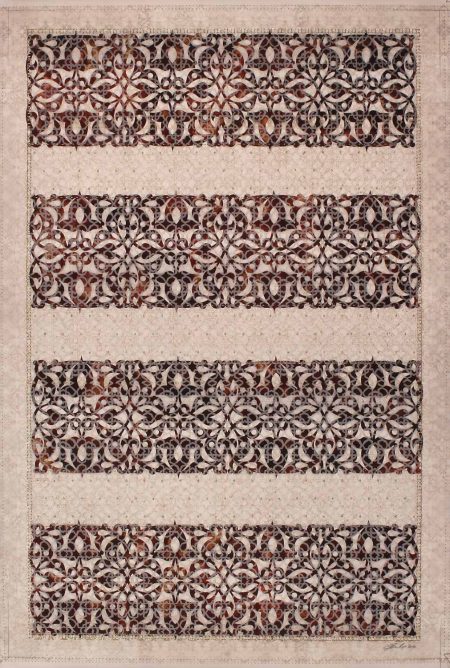
Susan Byrnes is a visual artist whose work encompasses traditional and contemporary forms and practices, including sculpture, multimedia installation, radio broadcasts, writing, and curatorial projects. She earned an MFA from Eastern Michigan University and a BFA from Syracuse University. She currently resides in Cincinnati, OH.
